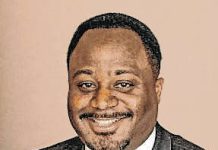For several years now, a painting by legendary Brown County artist T.C. Steele has hung in a Nashville home.
The subject is Samuel Wertz, a 19th and early 20th century educator in Bartholomew County.
If there is a value to the painting it is in the name of the artist. Some works by Steele, a member of the fabled Brown County art colony, have sold for thousands of dollars.
The value might be decreased because the likeness is that of a specific individual rather than a more encompassing work of nature in rustic Brown County.
Moreover, the painting was commissioned, further limiting interest.
Nevertheless, it is a T.C. Steele, and one would think it would be highly valued, especially by individuals or groups for whom the name Samuel Wertz might mean something.
Apparently not.
Before it was moved to its current Nashville location, the Steele portrait was in repose in the library of The Republic. It wasn’t even hung, just propped against a wall.
The painting had come into the hands of the late Stu Huffman, a former editor of The Republic. Stu came by it through a friend who had been one of Wertz’ relatives. It was bequeathed to the editor upon her death with specific instructions as to where she wanted it to be put on permanent display.
Unfortunately, no one wanted the painting. Stu had thought the most logical place would be in one of the Columbus high schools because Wertz was the original Columbus High School principal for 35 years in the late 19th and early 20th century.
School officials didn’t see it that way, in part because of the fear they would have to pay extra to have it insured.
Stu made repeated efforts to find an appropriate home for the Steele portrait but to no avail. When he retired in 1986, he simply packed it up and took it to his home.
Now it appears there’s a possibility that Samuel Wertz will finally get a suitable permanent home, but it won’t be in Columbus or even Bartholomew County.
It could end up at the University of Indianapolis — the institution of higher learning that the Columbus educator helped create more than a century ago.
The turnabout in the claiming rights for Samuel Wertz has to do with research being conducted by University of Indianapolis faculty member Michael Cartwright, who lives in Nashville.
Cartwright had contacted me earlier this month with a request for background information the newspaper might have about a controversial chapter in Bartholomew County history, one in which Wertz played a prominent role.
In he late 19th century, he was on the faculty of Hartsville College from which he had gradated in 1875. During his tenure as a teacher at the United Brethren in Christ school, he came to be highly respected but at the same time found himself in the middle of a heated debate about the school’s admission standards.
He became a spokesman for a group that was opposed to a policy adopted by the school’s president in which adherents of the Freemason society would be denied admission to the school. Wertz believed members of the so-called secret society had a right to keep their beliefs and participate in school activities.
The two groups defined themselves as the New Constitution and the Old Constitution parties. Wertz belonged to the New Constitution group. The Old Constitution group included another Hartsville teacher, Milton Wright, father of famed aviators Wilbur and Orville Wright.
In one sense, Wertz came out on the losing end of the split. He was fired by the president of the college in 1887 and eventually became a teacher at Columbus High School.
The split widened the church groups and is believed to have been instrumental in the closing of the school in 1897. A year, later the college building burned to the ground. One widespread rumor traced the blaze to a church sexton acting on behalf of the college president.
By that time Wertz had been promoted to principal of Columbus High School and had become a beloved figure in the eyes of both teachers and students. His 35 years as high school principal are unmatched in local history.
But his allegiance to his shuttered alma mater was as strong as ever. While members of the Old Constitution group tried to establish a link between Hartsville and the newly created Huntington College, Wertz maintained that the true Hartsville College was the original. He even organized a counter homecoming of Hartsville students to the school at Huntington, staging one here on the grounds of the burned out school.
While school principal here, Wertz maintained strong ties to the New Constitution wing of the United Brethren in Christ church. He was named to the original board of trustees investigating the potential for establishing a college in Indianapolis.
Wertz played several roles with this group, including raising funds. “He was pretty successful in that respect,” Cartwright said. “He even got (Columbus banker) Joseph Irwin to make a major contribution, and Irwin wasn’t even a church member.”
His efforts and those of others led to the establishment of what was then called Indiana Central College in 1912. It adopted its current name of the University of Indianapolis in 1986.
Wertz also played a major role in the development of the local United Brethren congregation. The church, which was then on 17th Street at Home Avenue, was believed to be the only local church named after a lay person.
He died in 1926 and up until the last few weeks of his life fulfilled his duties at the school. Hundreds filled the church that bore his name, the majority of them former students. A testament to the regard in which he was held by his students was that the T.C. Steele portrait was commissioned by the graduating class of 1912.
With the passage of time, Samuel Wertz’ name has faded from local history, but Michael Cartwright is intent on bringing it back for this and future generations.
In October, he plans to observe Founders Day for the University of Indianapolis by placing a wreath on Samuel Wertz’ grave in Garland Brook Cemetery. He is also preparing a talk about the former Hartsville College teacher to be delivered near the site of the old school.
And perhaps by then, T.C. Steele’s portrait of Samuel Wertz will have found a new home.
Harry McCawley is the former associate editor of The Republic. He can be reached at [email protected].




